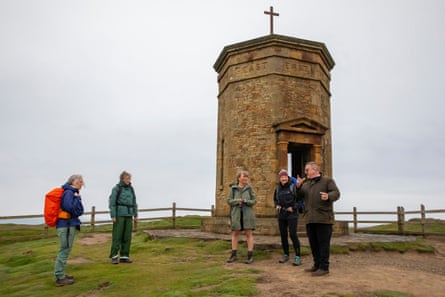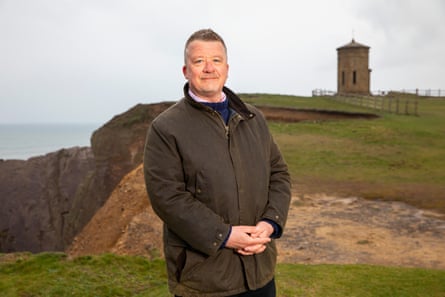
Race to rescue Bude’s Pepperpot lookout tower from being swept into the sea
The 188-year-old coastguard’s tower in Cornwall is to be moved 100m inland to save it from coastal erosion
Perched on an exposed clifftop above the Atlantic, which gnaws ominously at the sandstone and shale foundations below, Bude storm tower in Cornwall has helped to save many mariners from strife over the past two centuries. But now this cherished coastguard’s lookout is to be rescued itself.
The 188-year-old Grade II-listed tower at Compass Point, affectionately known as the Pepperpot, will be carefully deconstructed and rebuilt 100 metres inland later this month to avoid its otherwise inevitable loss over the cliffs to coastal erosion.
The move, which will cost about £450,000, was considered too expensive until locals and visitors showed their affection for the tower by raising £58,000 via crowdfunding in 2021.
Bude-Stratton town council pledged £40,000 towards the work and was granted £249,362 from the National Lottery Heritage Fund and £50,000 from Cornwall council.
“I call it a talisman for Bude and a romantic waymarker,” said Peter La Broy, a local councillor who hatched the idea to save the tower five years ago. “People always stop here for five minutes on their coastal walks and many people have told us they got engaged here.”

Designed by George Wightwick in homage to the Tower of the Winds in Athens and paid for by local benefactor Sir Thomas Dyke Acland, the 10th baronet, the tower has eight sides that map the points of a compass. It would have been occupied by a coastguard during high tides and storms, while a “tide-waiter” would have used the nearby flagpole to alert ships as they navigated the area’s treacherous waters.
“When I first asked the heritage office at Cornwall council about saving the tower, they didn’t have any interest or money,” said La Broy. “The conversation almost ended there. But then we started asking locals and the response was overwhelming.
“I was absolutely elated by the amount of money we raised. It was quite moving to know that I wasn’t alone in wanting to save the tower. Without that seed-funding we wouldn’t be saving it.”
Chris Jewell, 78, a local resident and history enthusiast, was among those who contributed. “When you’re coming into Bude from Holsworthy [in the east], the storm tower is the first thing you see over the hill,” he said. “It’s only a tiddly little thing in the distance, but when you see it you have a feeling that you’re home.”
Susanne Blake-Scholz, from Germany, came to see the tower while walking along the southwest coast path from Hartland Quay in Devon to Pityme in Cornwall with her friends. “It’s absolutely gorgeous,” she said. “It looks like a little Orthodox church with beautiful views out to sea. It would have been such a shame if it hadn’t been saved.”
The tower has already been moved a short distance once before, in 1881, after frost eroded both the cliff and the tower. The new work begins on 24 April and should take six months.
“The cliffs here are incredibly friable,” said La Broy. “The rate of erosion averages a metre per year but cliff falls are very unpredictable so you could lose 25 metres in one hour. We hope that by moving the tower back along the ridge it will survive for at least another 100 years.”

Each brick has already been 3D-imaged and tagged to ensure a faithful reconstruction, although the roof, which is not historic, will be replaced. One key decision is still to be made. “When it was built, the tower was aligned to magnetic north, which has changed over time, so it’s now approximately seven degrees out,” La Broy said.
“So that’s a question we need to resolve: should we align it to geographic north, or to magnetic north, or should we keep the existing alignment so that the views from each window remain the same? We think we’d like to retain the current views, even though we are bringing it down the ridge away from the cliff edge.”
- SEO Powered Content & PR Distribution. Get Amplified Today.
- PlatoData.Network Vertical Generative Ai. Empower Yourself. Access Here.
- PlatoAiStream. Web3 Intelligence. Knowledge Amplified. Access Here.
- PlatoESG. Carbon, CleanTech, Energy, Environment, Solar, Waste Management. Access Here.
- PlatoHealth. Biotech and Clinical Trials Intelligence. Access Here.
- Source: https://www.theguardian.com/environment/2023/apr/09/race-to-rescue-budes-pepperpot-lookout-tower-from-being-swept-into-the-sea
- :has
- :is
- :not
- 000
- 025
- 1
- 10
- 100
- 100M
- 10th
- 11
- 12
- 125
- 13
- 1300
- 14
- 15%
- 17
- 19
- 2%
- 20
- 2021
- 24
- 25
- 30
- 325
- 35%
- 362
- 4
- 5
- 6
- 65
- 7
- 725
- 775
- 8
- 9
- a
- About
- above
- absolutely
- Ad
- After
- ago
- Alert
- align
- aligned
- alignment
- almost
- alone
- along
- already
- Although
- always
- among
- amount
- an
- and
- Another
- any
- approximately
- April
- ARE
- article
- AS
- asked
- asking
- At
- avoid
- away
- back
- BE
- beautiful
- been
- before
- begins
- being
- below
- body
- border
- both
- Bringing
- buildings
- built
- but
- button
- by
- call
- came
- carefully
- centuries
- changed
- cherished
- church
- Climate
- CO
- Coast
- coastal
- coming
- Compass
- considered
- content
- contributed
- Conversation
- Cornwall
- Cost
- could
- Council
- critical
- Current
- decision
- described
- dialog
- disclaimer
- distance
- down
- during
- each
- eager
- East
- Edge
- eight
- elated
- element
- ended
- engaged
- ensure
- enthusiast
- Ether (ETH)
- Even
- existing
- expensive
- exposed
- faithful
- Falls
- false
- Feature
- feeling
- First
- five
- For
- Foundations
- friends
- from
- Frost
- geographic
- George
- German
- Germany
- got
- grade
- Have
- he
- headline
- helped
- her
- here
- heritage
- Hide
- High
- historic
- history
- homage
- Home
- hope
- hour
- HTTPS
- i
- idea
- if
- image
- in
- incredibly
- inevitable
- inland
- interest
- into
- IT
- ITS
- itself
- jpg
- Keep
- Key
- Know
- known
- la
- later
- least
- like
- lines
- LINK
- little
- local
- LOOKS
- lose
- loss
- lottery
- made
- Main
- many
- many people
- map
- Media
- minutes
- model
- money
- Month
- months
- more
- move
- moved
- moving
- National
- Need
- New
- None
- North
- now
- of
- Office
- on
- once
- ONE
- only
- or
- otherwise
- out
- over
- overwhelming
- paid
- past
- path
- People
- per
- Peter
- placeholder
- plato
- Plato Data Intelligence
- PlatoData
- Point
- points
- question
- quite
- Race
- raised
- raising
- Rate
- remain
- replaced
- rescue
- rescued
- resolve
- response
- retain
- reuse
- right
- roof
- Said
- same
- Save
- saved
- saving
- SEA
- see
- seven
- Shale
- she
- ships
- Short
- should
- showed
- Sides
- Sir
- SIX
- Six months
- slot
- So
- started
- Still
- Stop
- Storm
- storms
- such
- Supporting
- survive
- Take
- talking
- than
- that
- The
- their
- then
- There.
- These
- they
- thing
- Think
- this
- thomas
- those
- though?
- tides
- time
- to
- told
- too
- towards
- Tower
- town
- true
- two
- Uk
- unpredictable
- until
- us
- used
- very
- via
- views
- visible
- visitors
- walking
- walks
- wanting
- was
- Waters
- we
- when
- which
- while
- white
- WHO
- will
- window
- winds
- with
- without
- Work
- would
- year
- years
- you
- zephyrnet
